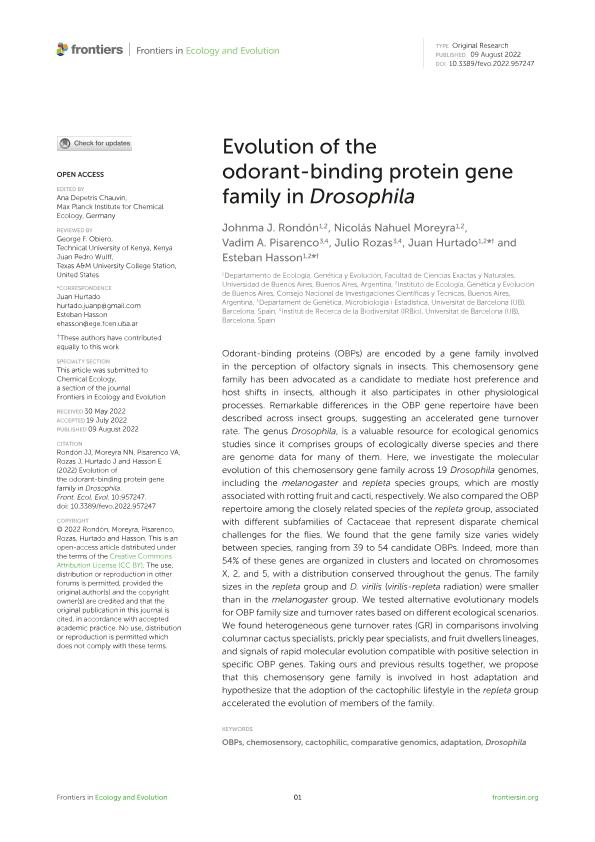Artículo
Evolution of the odorant-binding protein gene family in Drosophila
Rondón Guerrero, Johnma José ; Moreyra, Nicolás Nahuel
; Moreyra, Nicolás Nahuel ; Pisarenco, Vadim A.; Rozas, Julio; Hurtado, Juan Pablo
; Pisarenco, Vadim A.; Rozas, Julio; Hurtado, Juan Pablo ; Hasson, Esteban Ruben
; Hasson, Esteban Ruben
 ; Moreyra, Nicolás Nahuel
; Moreyra, Nicolás Nahuel ; Pisarenco, Vadim A.; Rozas, Julio; Hurtado, Juan Pablo
; Pisarenco, Vadim A.; Rozas, Julio; Hurtado, Juan Pablo ; Hasson, Esteban Ruben
; Hasson, Esteban Ruben
Fecha de publicación:
08/2022
Editorial:
Frontiers Media
Revista:
Frontiers in Ecology and Evolution
e-ISSN:
2296-701X
Idioma:
Inglés
Tipo de recurso:
Artículo publicado
Clasificación temática:
Resumen
Odorant-binding proteins (OBPs) are encoded by a gene family involved in the perception of olfactory signals in insects. This chemosensory gene family has been advocated as a candidate to mediate host preference and host shifts in insects, although it also participates in other physiological processes. Remarkable differences in the OBP gene repertoire have been described across insect groups, suggesting an accelerated gene turnover rate. The genus Drosophila, is a valuable resource for ecological genomics studies since it comprises groups of ecologically diverse species and there are genome data for many of them. Here, we investigate the molecular evolution of this chemosensory gene family across 19 Drosophila genomes, including the melanogaster and repleta species groups, which are mostly associated with rotting fruit and cacti, respectively. We also compared the OBP repertoire among the closely related species of the repleta group, associated with different subfamilies of Cactaceae that represent disparate chemical challenges for the flies. We found that the gene family size varies widely between species, ranging from 39 to 54 candidate OBPs. Indeed, more than 54% of these genes are organized in clusters and located on chromosomes X, 2, and 5, with a distribution conserved throughout the genus. The family sizes in the repleta group and D. virilis (virilis-repleta radiation) were smaller than in the melanogaster group. We tested alternative evolutionary models for OBP family size and turnover rates based on different ecological scenarios. We found heterogeneous gene turnover rates (GR) in comparisons involving columnar cactus specialists, prickly pear specialists, and fruit dwellers lineages, and signals of rapid molecular evolution compatible with positive selection in specific OBP genes. Taking ours and previous results together, we propose that this chemosensory gene family is involved in host adaptation and hypothesize that the adoption of the cactophilic lifestyle in the repleta group accelerated the evolution of members of the family.
Palabras clave:
ADAPTATION
,
CACTOPHILIC
,
CHEMOSENSORY
,
COMPARATIVE GENOMICS
,
DROSOPHILA
,
OBPS
Archivos asociados
Licencia
Identificadores
Colecciones
Articulos(IEGEBA)
Articulos de INSTITUTO DE ECOLOGIA, GENETICA Y EVOLUCION DE BS. AS
Articulos de INSTITUTO DE ECOLOGIA, GENETICA Y EVOLUCION DE BS. AS
Citación
Rondón Guerrero, Johnma José; Moreyra, Nicolás Nahuel; Pisarenco, Vadim A.; Rozas, Julio; Hurtado, Juan Pablo; et al.; Evolution of the odorant-binding protein gene family in Drosophila; Frontiers Media; Frontiers in Ecology and Evolution; 10; 8-2022; 1-14
Compartir
Altmétricas



